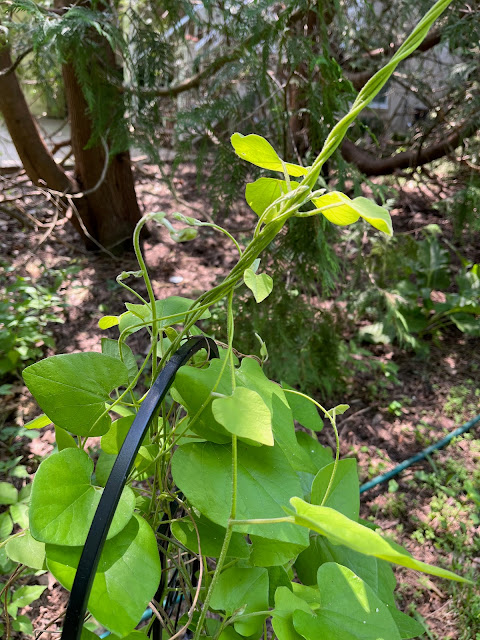This pipevine (planted seven years ago in a so-far-futile attempt to lure Pipevine Swallowtails) has extended above the adjacent trellis. It used to grab hold of a tree branch and continue climbing but I pruned that branch off. A single stem of the vine is too flexible to reach very high, but this one has braided itself using several strands, achieving a semi-rigidity that is enabling it to go ever higher looking for a grabbable site.

We have Oriental Bittersweet that does that - tendrils scouring the sky, seeking an anchor.
ReplyDeleteMaybe you should let your pipevine spread more - provide a bigger target for them puppies?
ReplyDeleteIt's rather aggressive and not native, so I feel I need to restrain it.
DeleteBefore you know it, it will be walking, and that will be the ent of us.
ReplyDeleteThat is a conundrum of a dilemma! Have you seen pipevine swallowtails in your yard / garden? If you have, then I say 'Let the pipevine spread! The heck with the rest of the state and the invasives." If your pipevine gets big enough, you may even establish a butterfly colony.
ReplyDeleteI've never seen them in our garden, but I spend too much time down in the basement writing for the blog. But nobody else has seen them in southern Wisconsin in years. The climate is changing; they may shift north in the years ahead. My pipevine will be waiting for them if they do.
DeleteA long extension cord? Wi-fi? laptop? those could get you outside and blogging; maybe even streaming?
DeleteTo add to my 'the heck with', https://en.wikipedia.org/wiki/Aristolochia says that "Many species of Aristolochia are eaten by the caterpillar larvae of swallowtail butterflies, thus making themselves unpalatable to most predators." Your pipevine on the loose may attract more than just the pipevine swallowtail.
ReplyDelete